Antibody data
- Antibody Data
- Antigen structure
- References [1]
- Comments [0]
- Validations
- Immunocytochemistry [2]
- Immunohistochemistry [2]
- Other assay [1]
Submit
Validation data
Reference
Comment
Report error
- Product number
- PA5-29507 - Provider product page

- Provider
- Invitrogen Antibodies
- Product name
- ACSL3 Polyclonal Antibody
- Antibody type
- Polyclonal
- Antigen
- Recombinant full-length protein
- Description
- Recommended positive controls: 293T, A431, Jurkat, Raji. Predicted reactivity: Mouse (95%), Rat (95%), Pig (95%), Bovine (96%). Store product as a concentrated solution. Centrifuge briefly prior to opening the vial.
- Reactivity
- Human
- Host
- Rabbit
- Isotype
- IgG
- Vial size
- 100 μL
- Concentration
- 0.81 mg/mL
- Storage
- Store at 4°C short term. For long term storage, store at -20°C, avoiding freeze/thaw cycles.
Submitted references ACSL3-PAI-1 signaling axis mediates tumor-stroma cross-talk promoting pancreatic cancer progression.
Rossi Sebastiano M, Pozzato C, Saliakoura M, Yang Z, Peng RW, Galiè M, Oberson K, Simon HU, Karamitopoulou E, Konstantinidou G
Science advances 2020 Oct;6(44)
Science advances 2020 Oct;6(44)
No comments: Submit comment
Supportive validation
- Submitted by
- Invitrogen Antibodies (provider)
- Main image
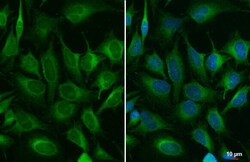
- Experimental details
- ACSL3 Polyclonal Antibody detects ACSL3 protein at endoplasmic reticulum by immunofluorescent analysis. Sample: HeLa cells were fixed in 4% paraformaldehyde at RT for 15 min. Green: ACSL3 stained by ACSL3 Polyclonal Antibody (Product # PA5-29507) diluted at 1:500.
- Submitted by
- Invitrogen Antibodies (provider)
- Main image
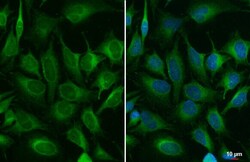
- Experimental details
- ACSL3 Polyclonal Antibody detects ACSL3 protein at endoplasmic reticulum by immunofluorescent analysis. Sample: HeLa cells were fixed in 4% paraformaldehyde at RT for 15 min. Green: ACSL3 stained by ACSL3 Polyclonal Antibody (Product # PA5-29507) diluted at 1:500.
Supportive validation
- Submitted by
- Invitrogen Antibodies (provider)
- Main image
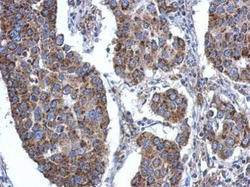
- Experimental details
- Immunohistochemical analysis of paraffin-embedded human breast cancer, using ACSL3 (Product # PA5-29507) antibody at 1:500 dilution. Antigen Retrieval: EDTA based buffer, pH 8.0, 15 min.
- Submitted by
- Invitrogen Antibodies (provider)
- Main image
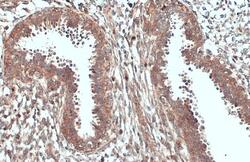
- Experimental details
- ACSL3 Polyclonal Antibody detects ACSL3 protein at cytoplasm by immunohistochemical analysis. Sample: Paraffin-embedded human breast carcinoma. ACSL3 stained by ACSL3 Polyclonal Antibody (Product # PA5-29507) diluted at 1:500. Antigen Retrieval: Citrate buffer, pH 6.0, 15 min.
Supportive validation
- Submitted by
- Invitrogen Antibodies (provider)
- Main image
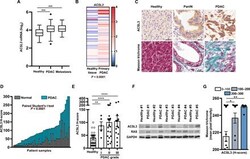
- Experimental details
- Fig. 1 ACSL3 is overexpressed in human PDAC. ( A ) mRNA levels of ACSL3 in patient healthy tissue, primary PDAC, and PDAC metastasis from the subset GSE71729. Healthy pancreatic tissue: n = 46 patients, primary PDAC: n = 145 patients, and PDAC metastasis: n = 61 patients. Data are represented as box (Whisker's) plot. Dots evidence outliers according to Tukey's method. ( B ) mRNA levels of ACSL3 in patient primary PDAC and matched adjacent healthy tissue from the subset GSE62452 ( n = 60). Data are expressed as entire numbers normalized by global average. ( C ) Representative IHC staining for ACSL3 (top) and extracellular matrix deposition marker with Masson trichrome (blue, bottom) of a human TMA showing primary healthy tissue, PanIN, and primary PDAC. Scale bars, 50 mum. ( D ) ACSL3 IHC quantification (H-score) of TMA comparing PDAC and adjacent healthy tissue ( n = 50 samples). We considered an H-score of less than 100, from 100 to 200, and above 201 having a low, intermediate, or high staining intensity, respectively. ( E ) Stratification of the patients by tumor grade from (D). Healthy tissue, n = 50 samples; grade I, n = 5 samples; grade II, n = 23 samples; grade III, n = 22 samples. ( F ) Immunoblot for ACSL3, total RAS, and glyceraldehyde-3-phosphate dehydrogenase (GAPDH) of five human patient-derived tumor samples and matched adjacent healthy tissue. ( G ) Correlation between ACSL3 and Masson trichrome staining of TMA from (C) and (D). Samples are divided in low, inte
 Explore
Explore Validate
Validate Learn
Learn Western blot
Western blot Immunocytochemistry
Immunocytochemistry